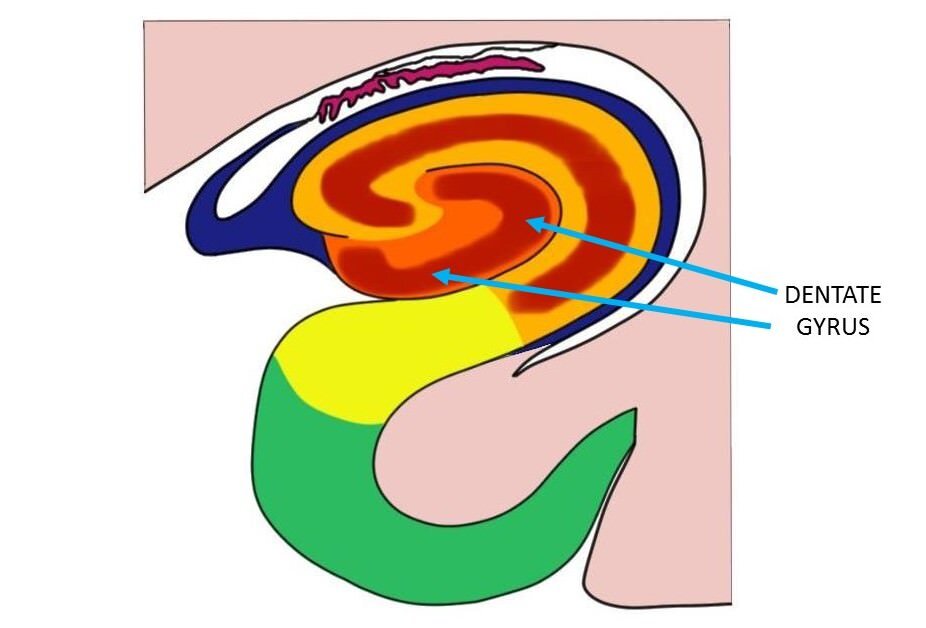Know Your Brain: Dentate Gyrus
Where is the dentate gyrus?

The dentate gyrus is found in the temporal lobe, adjacent to the hippocampus. There is not a consensus, however, on how to anatomically demarcate the hippocampus and its neighboring regions, and some sources consider the dentate gyrus to be part of the hippocampus. Other sources regard the dentate gyrus as distinct from the hippocampus, and consider it to be part of the hippocampal formation—a term used to refer collectively to the hippocampus and its surrounding structures.
What is the dentate gyrus and what does it do?
The hippocampus is thought to be involved with a number of important brain functions, but is best known for its role in tasks like memory, spatial orientation, and spatial navigation. To contribute to these functions, the hippocampus needs to receive sensory information (e.g. about vision, smell, touch) from the cerebral cortex. The dentate gyrus is thought to provide that information, acting as the main source of input to the hippocampus.
The information the dentate gyrus communicates to the hippocampus comes first from another region, the entorhinal cortex, and is carried from the entorhinal cortex to the dentate gyrus via a pathway known as the perforant pathway. When the dentate gyrus receives this information, however, the structure is not thought to act simply as a passive conveyor of the data. Instead, it is thought to be the site of initial processing for that information, analyzing and categorizing it so the hippocampus can make better use of it.
The dentate gyrus, for example, is hypothesized to be involved with sorting incoming information based on shared characteristics, a process known as pattern separation. In other words, the dentate gyrus might receive similar sensory signals (e.g. the smell of cookies baking) from two different locations (e.g. your home and a bakery). It is then thought to play a role in distinguishing these sensations based on where they were perceived, before sending the information on to the hippocampus. This could help the hippocampus create two distinct memories rather than a confusing jumble of the experiences.
On the other hand, the dentate gyrus is also thought to be involved with associating sensory information with the appropriate context. For example, while in the situation above the dentate gyrus is playing a role in keeping two similar olfactory experiences distinct, it also might help to link those olfactory experiences to the correct environments (i.e. your home and the bakery, respectively).
Through these functions that involve either the combination or differentiation of information, the dentate gyrus can facilitate the accurate encoding of memories, which also expedites accurate memory retrieval. Therefore, the dentate gyrus is thought to make an important contribution to the memory functions typically attributed to the hippocampus.
Another unique feature of the dentate gyrus is that it is one of only two areas in the brain that has been found to produce new neurons (a process known as neurogenesis) over the course of the lifespan. The new neurons formed in the dentate gyrus may be incorporated into the dentate gyrus and hippocampus to play a role in learning, memory, and the related tasks mentioned above. There is also some evidence that dentate gyrus neurogenesis could be important for mood regulation, and therefore might be a target in the treatment of mood disorders like depression.
Thus, although it is often overshadowed in perceived importance by the hippocampus, the dentate gyrus has some unique characteristics and is thought to play an integral role in facilitating hippocampal function. Still, we have yet to reach a complete understanding of the dentate gyrus, and there is much more for future research to uncover.
References (in addition to linked text above):
Amaral DG, Scharfman HE, Lavenex P. The dentate gyrus: fundamental neuroanatomical organization (dentate gyrus for dummies). Prog Brain Res. 2007;163:3-22.
Kesner RP. A behavioral analysis of dentate gyrus function. Prog Brain Res. 2007;163:567-76.
Scharfman HE. The enigmatic mossy cell of the dentate gyrus. Nat Rev Neurosci. 2016 Sep;17(9):562-75. doi: 10.1038/nrn.2016.87. Epub 2016 Jul 28.


